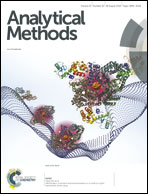Quantification of estrogens in infant formulas by isotope dilution liquid chromatography-tandem mass spectrometry†
Abstract
Steroid estrogens, such as estrone (E1), 17β-estradiol (E2) and estriol (E3), have been shown to exhibit potentially adverse effects on the health of children. Consequently, it is highly desirable to develop detection approaches for rapid and accurate determination of steroid estrogens in infant formulas. In this study, a robust method based on isotope dilution liquid chromatography-tandem mass spectrometry (ID LC-MS/MS) was developed to simultaneously measure E1, E2 and E3 in infant formulas with no need for any derivatization step. The desired simplicity, accuracy and specificity were achieved via a facile sample pretreatment process, including protein precipitation and clean-up steps. The limits of quantification were 0.0025, 0.005 and 0.005 μg kg−1 for E1, E2 and E3, respectively. Besides, a recovery of 92.3–102.7% was obtained with a relative standard deviation of less than 6%. Furthermore, both accurate values for the target analytes ranging from 0.005 to 50 μg kg−1 and a corresponding expanded relative uncertainty of less than 12% were obtained using the ID LC-MS/MS method. More importantly, the approach is highly sensitive, selective and accurate in screening estrogens in real infant formula samples. Thus, it could be convenient for large-scale application due to its derivatization-free feature and simplicity in sample preparation.



 Please wait while we load your content...
Please wait while we load your content...